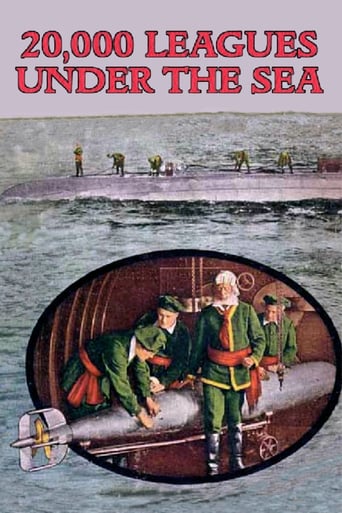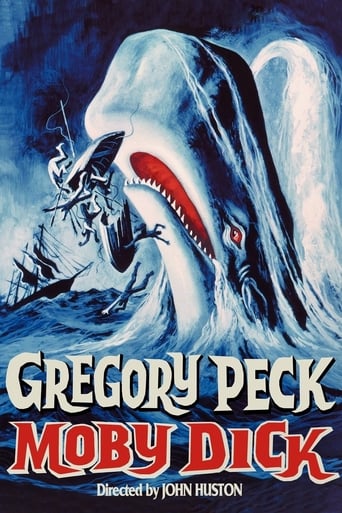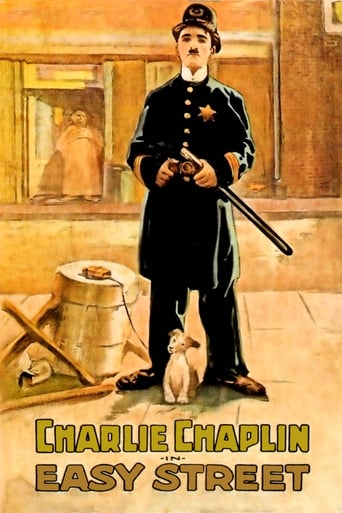


20,000 Leagues Under the Sea
Captain Nemo has built a fantastic submarine for his mission of revenge. He has traveled over 20,000 leagues in search of Charles Denver - a man who caused the death of Princess Daaker. Seeing what he had done, Denver took the daughter to his yacht and sailed away.
-
- Cast:
- Allen Holubar , Jane Gail , Howard Crampton , Matt Moore , William Welsh , Joseph W. Girard , Curtis Benton


Similar titles









Reviews
If you like to be scared, if you like to laugh, and if you like to learn a thing or two at the movies, this absolutely cannot be missed.
The story, direction, characters, and writing/dialogue is akin to taking a tranquilizer shot to the neck, but everything else was so well done.
One of the most extraordinary films you will see this year. Take that as you want.
It is neither dumb nor smart enough to be fun, and spends way too much time with its boring human characters.
A remarkably lavish production that seems not content with merely filming Jules Verne's 1870 novel but for good measure also throws in his later novel 'L'Île Mystérieuse' and a concluding flashback that - as the subtitles themselves admit - owes nothing to Verne but must have made an already expensive production needlessly extravagant (Universal's Carl Laemmle took a bath - if you'll pardon the expression - on the reported $500,000 he spent on it).The most remarkable aspect of the film is the pioneering underwater photography supervised by the brothers Ernest & George Williamson (some of it shot in the Bahamas) depicting the view from Captain Nemo's famous picture window, the camera lingering lovingly on strikingly modern-looking actuality footage of coral reefs and shoals of fish. When Nemo's crew get into their diving suits there is then remarkable footage of them interacting with actual sharks; although the realism abruptly evaporates in a later scene involving an extremely phony looking octopus.The film's makers quickly lose interest in a straight adaptation of Verne's novel at this point, and the action transfers to a mysterious desert island whose one human inhabitant is initially a boisterous 'child of nature' played by Jane Gail in dusky body makeup, who jauntily trades in her cheetah skin sarong for a fetching combination of blouse and trousers provided by one of the visitors. (Quite a few adventure films from this period that I've seen have put the leading lady in trousers.) Nemo, alias Daaker, turns out to have been an Indian prince in a previous life, and Miss Gail turns out to be his daughter, as is explained in a flashback thrown in climaxing in a native uprising. The film had at this point seemed to be drawing to its conclusion; which makes the insertion of this very expensive looking sequence reportedly featuring almost 2,000 extras all the more bewildering.The extraordinary underwater footage aside, the handsome and atmospheric look of the rest of the film probably owes more to the photography of Eugene Gaudio (whose elder brother Tony's long career at Warner Bros. included 'The Adventures of Robin Hood') than to the rather perfunctory direction of Stuart Paton, who should have told Allen Holubar as Nemo and the unidentified actress playing his late wife not to wave their arms around so much. Other reviewers have commented on the resemblance of the uniform worn by Captain Nemo and his crew to the one traditionally worn by Santa Claus.
Monday November 2, 7pm, The Paramount, Seattle "Slowly, silently, it rises from unfathomable depths." A French scientist leads an expedition sent to find and destroy a gigantic, menacing sea monster. He discovers instead a dark, vengeful anti-hero that controls the "monster" and complications ensue.The third motion picture (American Mutoscope & Biograph 1905, Georges Méliès 1907) based on Jules Verne's Vingt Mille Lieues sous Les Mers from his legendary Voyages Extraordiniares, Universal Film Mfg. Co's 20,000 Leagues Under the Sea (1916) is noteworthy for the technically astonishing underwater photography of John Ernest Williamson's Submarine Film Corporation. Produced by Carl Laemmle over a two-year period in the Bahamas, at Universal's Leonia, New Jersey and Universal City, California facilities, for a reported cost of $500,000 (roughly $100,000,000 today), the screenplay also incorporated elements of Verne's Mysterious Island. The technology of Williamson's "Photosphere" observation chamber, used to film encounters with undersea creatures, rivals the fictional science of Verne's novel and helped establish the fantasy-horror legacy of Universal Studios.
When I read during the opening credits of the 1916 adaptation of Jules Verne's "20,000 Leagues Under the Sea," immediately I assumed the frame of mind that I always do when watching early films, so as not to criticize it's lack of special effects or advanced film techniques. Immediately I was immensely impressed at the transfer from book to film, as the film followed the story closely and faithfully.Unfortunately, this only lasted for about the first ten minutes of the film, which ultimately proved to take Verne's work and butcher it in every way imaginable. Probably the most jarring change to the story is that they decided to not only adapt 20,00 Leagues, but also another Verne novel, Mysterious Island, into this film. So the result is that you have two totally different stories taking place that don't at all seem to fit together, until finally they come together in the bizarre conclusion, which makes absolutely no sense in respect to the novel.My current theory is that because so much of the original novel of 20,000 Leagues was decades beyond the reach of the filmmakers to be able to put on screen, so they probably had to look to an entirely separate novel just to have enough material to fill a full length film. Sadly, it reminds me of those terrible songs that radio stations sometimes come up with when they combine two popular songs together that have a similar beat, resulting in something that is not quite equal to but definitely less than the originals. One such bizarre hybrid comes to mind involving Closer, by Nine Inch Nails, and Garbage's #1 Crush.The basic, basic, basic plot structure remains, but literally 95% of the story is gone. There is rumor of a massive sea monster and the crew of the Abraham Lincoln set off to capture it. Strangely enough, at one point it passes a mere few meters from their ship in broad daylight, and the crew can clearly see the steel plated sides and the rivets holding it together, even the bridge and periscope, and yet they still think it's a sea monster. I'll attribute that to the inability to emulate the Nautilus's movements as described in the novel, but in this way we also have to sacrifice the entirety of the ship's glorious design and function, which is not even described in dialogue. For the most part, we see a single room, which looks like an old Victorian bedroom with one wall that looks like it belongs in a boiler room. Probably the worst crime that the film commits is in the character of Captain Nemo. Granted, Nemo in the novel is not exactly the most charming and charismatic man, but it is as if they set out in this film to create a man as far from the original description as humanly possible. As a result, we get a bizarre spectacle that looks like a disgruntled Santa Clause in blackface. And not only that, throughout the film he gives several displays of compassion that the original Nemo would have scoffed at. Indeed, at one point, he torpedoes a ship, and then afterwards and then almost faints as he worries about the safety of the victims. What the hell?? And incidentally, Verne's Nautilus didn't have torpedoes, although he did use it as a ramming weapon.In the film's defense, the underwater photography is truly impressive given the time that it was filmed, and surely knocked 1916 audiences, most of whom had probably never seen the underwater world, out of their seats. This would certainly explain the seemingly endless lingering on these scenes. Their is also an interesting allusion to another Verne novel, as at one point in their underwater tour they come across a decayed shipwreck, which Nemo describes as "the wreck of an old blockade runner."And the worst thing about the bizarre personification of Nemo in this film is the backstory that was invented for the film which, amazingly, is introduced with this intertitle - "Captain Nemo reveals the tragic secret of his life, which Jules Verne never told."What follows is the most bizarre story imaginable, which claims that Nemo was previously some kind of empirical royalty who lived in an empire "beyond the sea." One man wrongs him, which doesn't explain his subsequent disdain, and even hatred, for all of mankind of all nations, nor does anything explain why he took to the sea. And incidentally, Nemo is a man of art, science, biology, history, astronomy, etc. The transition from his old life to the one we see is totally senseless. It may very well be that this was one of the first major films to set the trend of adapting novels to film, and while modern adaptations still make ridiculous changes to story and characters where they don't belong, at least those inexplicable liberties seem to have diminished since 1916!
This may have been thrilling in 1916, but today it seems more of a curio. The Williamson brothers invented a camera to take pictures underwater, (the prologue tells us, complete with photos of them) so there's lots of shots of fish swimming, the bottom of the sea, men in diving suits and one battle with an octopus, which was a bit fuzzy. Still, the sense of watching movie history was strong, but don't expect too much in light of more modern techniques. What really bothered me was the hammy acting styles, with lots of arm motions and exaggerated facial features. It's the style that gave silent films a bad name. One who avoided this was Matt Moore, the hero of the film, and the only actor I recognized. Perhaps that is why he was still making movies in the 50's. The film uses plot elements of Verne's "The Mysterious Island" as well as "Twenty Thousand Leagues Under the Sea."











